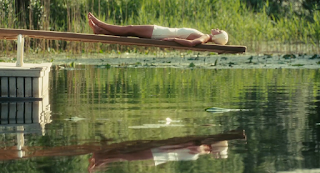Este post foi escrito para a série Hit Me With Your Best Shot do blogue The Film Experience de Nathaniel Rogers, sendo que é aqui apresentado em inglês, ao invés do que é usual neste blogue.
First of
all, I’d like to apologize for the length of the text, but Atonement is a film that
means a lot to me (as any Portuguese readers can attest in my review) and I
couldn’t pass the chance to talk about my appreciation of it, and especially my
love for the shot I picked, the film’s ending and one of my favourite
actresses. Before all that though, here are 10 runner-up shots in chronological
order:
As you can
see, Atonement
is a gorgeous film, beautifully shot by Seamus McGarvey under the direction of
Joe Wright and designed by Sarah Greenwood and Jacqueline Durran, whose sets
and costumes are an essential part of the film’s overall success. I have to
confess that despite their brilliance, I chose a shot that features neither
sets nor costumes. I know this may be considered an obvious choice for best
shot but here it is:
My Best Shot
I understand
many fans of Ian McEwan’s novel truly despise the ending conceived by Tom
Stoppard and Joe Wright, which allows Briony to publically confess the crimes
that have consumed her life, while in the novel such unwavering and unexpressed
guilt follows her unto her grave, with the book, posthumously published, acting
as her titular act of atonement. While it’s true that the film drastically
changes this finale, by ending on an interview where Briony explains her
intentions with the publication of her, Cicely and Robert’s story, and
confesses both to the world and to the audience the way in which she destroyed
their lives through lying, I would like to believe that such changes don’t
perniciously affect the film or make it a less complex work, rather the
contrary.
You see, to
me, Atonement
is not a film about a love story, and not even about guilt, but rather a film
about storytelling itself, its powers, and the personal tragedy of this
particular author. That’s why I’m never bothered by the extremely self-conscious
construction of so much of the film’s mise-en-scéne, since that same
construction is part of the film’s thematic centre. The finale exacerbates this
but also becomes, in its own special way, a celebration of happy endings as a
narrative mechanism. Is it wrong to show kindness and forgiveness to one’s own fictitious
characters? I find it’s precisely in that artificial construction and falseness
of the final narrative coup that Atonement finds its most
transcendent and human dimensions.
Considering
such a heartfelt defence of happy endings it seems fitting that the film’s authors
decided themselves to show generous empathy and forgiveness towards their
protagonist, a fellow storyteller, allowing her to find some solace in life.
And it isn’t as if this conclusion to Bryony’s story is of particular
joyfulness and absolute catharsis, after all she’s slowly succumbing to
dementia and it’s quite clear that she has spent her entire life under the
strenuous and crushing burden of her guilt.
I’ve talked
about the ending of the film’s narrative, but I’ve not even mentioned anything
about my specific pick for best shot, that gorgeous close-up of Vanessa Redgrave’s
face.
Speaking
less about narrative and more about form, I do believe this is one of Atonement’s
most beautiful visuals. It’s true that the film is filled with gorgeous images,
like those countless shots of a summer afternoon where the bodies seem to irradiate
heat, those almost operatic landscapes of wartime devastation, or the severe
and purposeful shots of Briony swiftly moving through white hospital corridors.
Nonetheless, it’s difficult to deny the power of the human face as an image. My
favourite director, Ingmar Bergman, for example, built great part of his style
on that very same understanding of the visual power of a human face, shot in close-up
and confronting the audience with its humanity.
Speaking of
Bergman, this shot reminds me a great deal of the final image of Harriet
Andersson in Summer with Monika, one of the best films of the Swedish
master’s early work. Like in the 1953 film, the audience is confronted by the
direct look of the film’s protagonist as the space around her disappears into
shadows, leaving the public with no escape but to confront those piercing eyes.
Despite this visual similarity, the effect of both shots is quite different,
mostly due to the work of its actresses. While Andersson turns that look into
something like a defiant confrontation of her audience, Redgrave is doing
something much more akin to a tender plea for empathy, understanding and mercy.
In Briony’s eyes we don’t see defiance, but a need for forgiveness, for some
sort of absolution before her sickness drowns her in the waters of oblivion.
There’s something seismic about the simplicity of such an image, something
powerful that transcends the film’s artificial construction, justifying it at
the same time it explodes the entire edifice of the narrative with a moment of
searing painful humanity.












Loved this writeup. Thanks for that. You really captured the meaning of that scene beautifully.
ResponderEliminarlove it too. Vanessa Redgrave is such a presence... and the casting of the three Brionys is really just super... they all have such memorable eyes but not in the same way which is fine for a film that is not strictly true but fiction about truth and so on.
ResponderEliminar